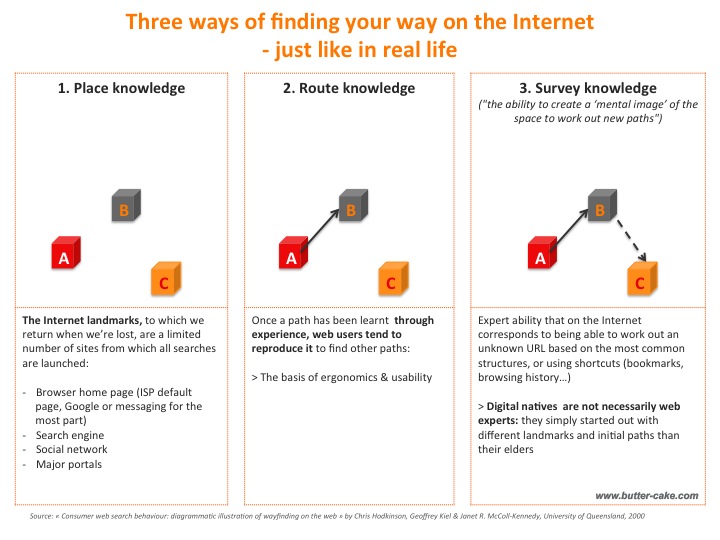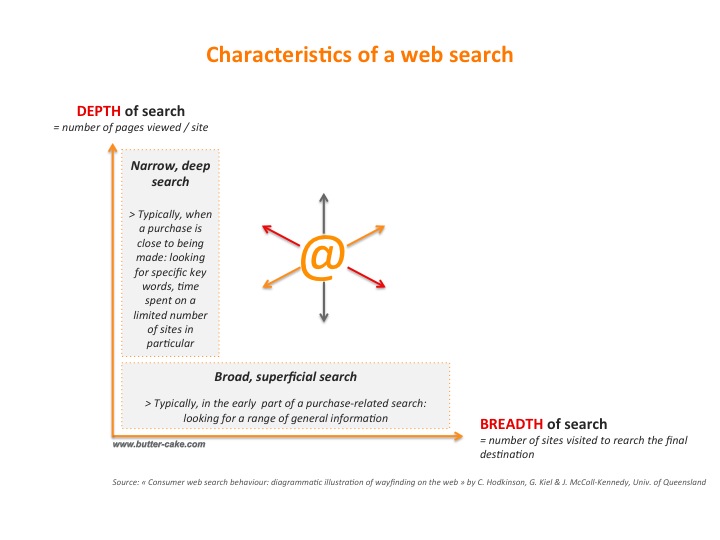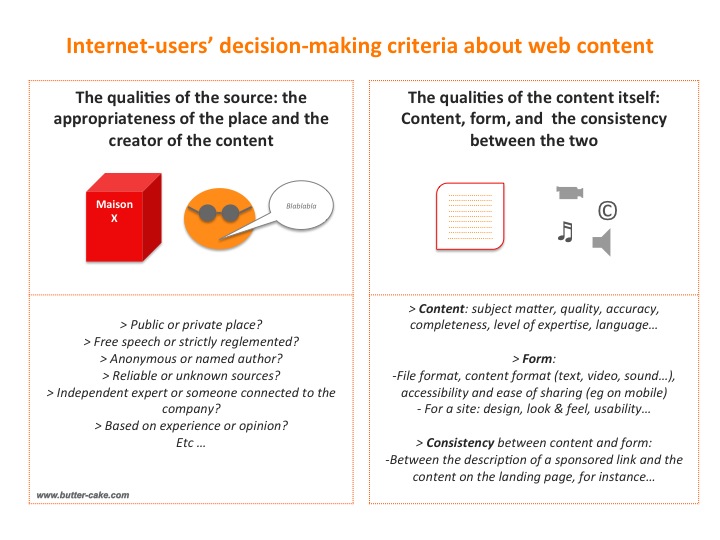Overview: The Internet is a virtual space in which we find our way around in the same way as we do in the real physical space: using points of reference and paths that come from experience enabling us to build up a mental image of the space. Content is the tar of the web, the material that is used to build its roads: a strategy of content and a strategy of means are closely linked. Internet users continually pass judgement on the content they find until they reach their goal. Their criteria are often based on the quality of the source as much as on the quality of the content itself.
On the Internet, a strategy of means and a strategy of content are closely linked, and it is relatively ineffective to spend money on attracting web users if the content of the brand or company the users will be exposed to has not been appropriately thought out. To do so, having a global vision of the Internet and Internet usage is not enough. We also need to understand how users proceed to achieve their goal and how they make their choices along the way, because depending on their needs, the category and products/services they are looking for and their personal experience, they may not necessarily follow the same digital “paths” or be receptive to the same arguments.
How do we find our way on the Internet?
How we move around and find information on the Internet is perfectly comparable to how we move around and find our way in real life. In real life, there are three main ways of moving around that have been studied and recognised in the social sciences (source: “Consumer web search behaviour: diagrammatic illustration of wayfinding on the web” by Chris Hodkinson, Geoffrey Kiel & Janet R. McColl-Kennedy, University of Queensland, 2000):
– The simplest and the easiest to acquire by experience is place knowledge, i.e. the ability to recognise specific places such as the entry to a city or a roundabout that you know, etc. When we are lost, we come back to these places that we know, which become landmarks. On the Internet, the places we know are our home page, which is displayed by default when we open our browser (usually the web site of our ISP or Google on a computer, and apps on an iPhone…) and the main sites we use (search engine, social network, email, major web portals…). When users get “lost” on the web, they find their bearings again in the same way as they do in real life by coming back to a place they know to launch a new search; this place is often their favourite search engine. This approach is particularly important to understand because it shows how all searches begin: a large part of the web audience in France is concentrated on a relatively limited number of sites: Google, portals and social networks! The most common means of search on the Internet are thus easy to infer:
> Direct search by typing key words in a search engine
> Browsing from link to link
> Soliciting
– The second type is route knowledge, i.e. the ability to move from Point A to Point B using known landmarks. It is acquired by experience, for instance when finding the way to go to a new job. As in real life, once web users have established the paths they move through, they tend to use them again and again, even to go to new places: human beings do not like to change their habits unless they have an obligation or a compelling motivation to do so. The personal experience of each user thus influences his or her future search method since it determines patterns that are likely to become repetitive and therefore predictable (this is the whole basis of ergonomics, the study of which should not be limited to navigation through a site and a screen-by-screen approach but should also look at the user’s overall “journey” or workflow).
– The third type is the ability, based on the first two types, to combine them in order to create a “mental picture of a space” (“survey knowledge”). This ability is the most sophisticated one to acquire, as it allows us, based on known elements and our experience of certain paths, to work out a new way of reaching a place, use shortcuts, and not get lost… On the web, it corresponds to the ability to work out an unknown web address based on the most common URL structures, for instance. This ability is what makes the difference between a novice user and an expert, even if web browsing is relatively simple (mainly search, back and forward for less experienced users + more use of direct URL, bookmarks and history for more advanced users).
The level of expertise in use is not linked solely to the knowledge of certain places or paths. For this reason, contrary to popular belief, young “digital natives” are not necessarily more expert in their use of the web; rather, when they start using a computer or a phone, they have simply created other starting points and landmarks and other paths than those used by their elders, who in some cases started using the web earlier and have since found it hard to change their habits… According to a study by the NNG, for instance, young college students look for companies using a search engine rather than typing the URL directly and it often takes them several attempts to find a piece of information on a web site because they browse quickly and fairly ineffectively.
What makes for effective search are therefore the user’s expertise in searching the web and his or her personal profile, along with other criteria which will depend more on the user’s needs at a given moment and the type of product being sought.
Which search strategies correspond to which needs?
By drawing on the different ways of browsing described above, a web search can be characterised by two main elements: its length (that is, the number of sites visited to reach the ultimate destination you are looking for) and its depth (that is, the number of pages read per site). A search can be narrow and deep, or broad and superficial.
Typically speaking, the “earlier” users are in their search (in the course of a purchase, for instance), the more likely they are to enter generic key words into search engines, and the greater chance there is that they will carry out a broad, superficial search, as they will tend to look for a variety of information sources to get an idea about a topic. The closer they are to their goal of making a purchase or consuming something, the more likely they are to enter specific key words into search engines (brand names…), and the greater chance there is that they will carry out a search that is narrow (fewer sites) but deep (more pages per site). Natural or paid SEO certainly needs to include these different families of key words associated with the different stages of a search… not to mention the key words that relate to searches made once the purchase has been made!
This mapping of Internet traffic enables us to understand the “means of transport” used by web users and the different types of searches they carry out, which helps a brand to build its own strategy of means to enable its clients and targets to reach it in the most effective way, thus balancing out permanent structural investments (SEO and content) against tactical investment (media campaigns). The more solidly-built and well laid-out the major roads are, the more effective tactical campaigns will be, as these two types of means are not in opposition but rather should be built in a complementary fashion.
What criteria do Internet users use when making choices?
Tracing out beautiful roads is not enough to bring Internet users to your door – you also need to convince them to visit you rather than someone else. So we still need to look at the criteria that influence Internet users when it comes to taking decisions and making choices. Some of them can be seen from the key words used to search in a search engine (the items displayed by Google, for instance) while others will be more judged “on site” (when the user arrives at your web site). The idea here is not to go into detail but rather to look at the broad groups of criteria, since literature abounds on the web about these subjects.
The qualities of the source: the appropriateness of the place and the creator of the content
The absence of walls often gives the illusion to some that the Internet is an open, public space, but the same rules apply there as in the real world: there are private places and there are public places, and the types of content as well as their qualities depend very strongly on this distinction. Internet users know this or, generally-speaking, they discover it pretty quickly, so transparency is the best rule of conduct to adopt. For a brand or a company, this means that the content it delivers has a strong chance of being thought of as less credible than if it came from an external source, with some sources being thought of as more credible or more “expert” than others (depending on the topic and on the experience this may be the media, amateur bloggers, consumer forums, official sources, etc.). With experience, Internet users can make their own assessment regarding the quality of a source, and we should not be too quick to generalise and claim that the most reliable sources are automatically friends and acquaintances, or consumers. In fact, users learn more than anything to use multiple sources to validate any information they find. In places where multiple authors may participate, details about the author (his or her name, role and profile…) help increase this credibility. A company that lets different employees express themselves on its blog under their own names will automatically have greater credibility than one where “admin” posts information in a corporate tone.
It is this search for credibility that underpins all the strategies for influence that companies are trying to build, with greater or lesser success depending on the quality of the approach and the amount of time invested. Despite what many brands believe, it is not by trying to “control” their digital reputation and what is being said about their products and services that they will gain more credibility and attract more Internet users, but rather by replying to consumers and encouraging them (and employees) to speak freely (which means trying to solve problems rather than hide them…). This attitude has room to grow in France, where generally-speaking there is a reluctance on the part of companies to exchange freely with consumers or let their employees interact with them openly and publicly, despite success stories that prove the unquestionable value of this approach (Best Buy, Zappos…).
Qualities of the content itself
The various attributes of a piece of content relate both to its informational content (quality, accuracy, completeness, level of expertise, language…) and to its form (text, images, videos, length, how easy it is to share/distribute…, design, look and feel, usability, ease of navigation for a site…). The key, distinctive elements must certainly be highlighted in terms of usability and best practices for SEO, or you risk shooting yourself in the foot. How many links returned by Google are not clicked because the two-line description doesn’t do justice to the content it describes? And how many Internet users spend just a couple of seconds on a page before leaving to go elsewhere because they are disappointed by what they find – or don’t find – there?
There is an abundance of literature on the web relating to best practices in usability and SEO, and we will not get into detail about these subjects here. We just want to emphasise the fact that they should not be treated as separate disciplines to be handled by independent specialists, but rather linked together and always kept in mind alongside those two goals which meet at the crossroads of usability and SEO: the objective of the Internet user who has a need or a goal to accomplish, and the objective of the brand or company who has a target to reach. Content is the tar of the web in the sense that it is the raw material which makes up its roads: considering it as an item to be sold by the pound as if it was of little value is a risky long-term strategy, and may also have a negative impact on brand image and awareness (as was shown by the recent impact of Google updating its algorithm on American “content farms”).
In conclusion, the ways of Internet users are hardly mysterious – they follow logical rules that evolve with experience. A strategy of means and a strategy of content are two sides of the same coin, and while they may require the contribution of different specialists for their implementation, they must be coordinated and shared within the company if they are not to create roads that are unconnected or lead down a dead-end… From this perspective, the Internet levels out the playing field for different types of companies and offers many interesting opportunities for small and medium businesses, who do not have the same financial might as very large accounts but may prove far more agile when it comes to changing their organisation and their attitude to communication, adopting content and client relationship strategies that are much more open and in line with the possibilities and the philosophy of the Internet. The full potential remains to be discovered!
This article is the fourth chapter of the ebook « Building a digital strategy », available for download in PDF format on this site. The following articles develop a methodology for designing a digital strategy based on a brand or business strategy.



